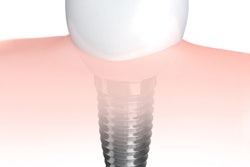
How well do narrow-diameter implants perform compared with regular-diameter ones? Are crestal bone loss and survival rates similar? Since research is limited and contradictory in this area, one investigator performed a systematic review and meta-analysis to learn more.
The review included studies that compared crestal bone loss and survival rates for narrow-diameter and regular dental implants. The findings of the analysis suggested that results were similar with the two implant types, but that the conclusions should be interpreted with caution, the review author noted in the Journal of Investigative and Clinical Dentistry (November 9, 2018).
"Narrow-diameter implants and regular diameter implants showed comparable crestal bone loss and survival rates," wrote Mohammed Alrabiah, BDS, MSD, of the department of prosthetic dental science at King Saud University in Riyadh, Saudi Arabia.
Analyzing the results
The use of narrow-diameter implants can help avoid the use of bone grafts and alveolar crest expansion in situations including narrow alveolar ridges, limited interradicular or mesiodistal spaces, or reduced alveolar height, according to Dr. Alrabiah.
Clinical research results have found similar survival rates with narrow-diameter implants compared with regular ones, but other studies have suggested that they have a comparatively greater risk of crestal bone loss and less strength. However, some studies have biases, and there are no previous systematic reviews comparing crestal bone loss for the two implant types, he noted.
“Narrow-diameter implants and regular diameter implants showed comparable crestal bone loss and survival rates.”
Dr. Alrabiah conducted the current systematic review and meta-analysis to establish survival rates and determine crestal bone loss for narrow-diameter implants compared with regular-diameter one
He searched various medical databases for retrospective or prospective randomized or nonrandomized clinical trials published in English from 1980 through May 21, 2018, in which the use of narrow-diameter implants was the intervention of interest, and survival rates and peri-implant crestal bone loss were outcome measures.
The review included four studies in the qualitative assessment and three of the studies in the quantitative assessment. Two of the studies were retrospective, one a prospective nonrandomized trial, and one a split-mouth, randomized controlled trial. Extracted data from the studies included factors such as demographics, patient satisfaction, and complications.
The author judged one study as high quality, with a low risk of bias, and the quality of the remaining three studies as unclear.
The studies each included from 22 to 119 participants who ranged in age from 17 to 93 years. The participants underwent treatment with a total of 205 titanium narrow-diameter implants and 134 titanium regular-diameter implants that were placed in posterior jaws in three studies and the anterior zone in one study. In the included studies, narrow-diameter implants were defined as 3.3 mm or smaller.
The implant survival rate in the four studies ranged from just over 93% to 100%, and the follow-up period was from three to five years. No implant failure occurred due to implant fracture.
In three studies, crestal bone loss and survival rates at follow-up were similar between narrow-diameter implants and regular implants, while one study found increased crestal bone loss around narrow-diameter implants compared with regular implants.
The three studies included in the quantitative meta-analysis all analyzed only posterior implants. The author calculated comparable crestal bone loss and survival rates for narrow-diameter implants and regular implants included in these studies. However, he found significant heterogeneity for crestal bone loss for both implant types. Additionally, there was a favorable trend toward narrow-diameter implants for survival rate and a slight favorable trend toward regular implants for crestal bone loss.
"The data and meta-analysis presented in the present review are not sufficient to estimate the long-term success and implant failure of narrow-diameter implants," Dr. Alrabiah wrote. "However, the three- and five-year results of the studies included in the present review did not demonstrate any significant differences."
More research needed
The biggest limitation of the current review was the small number of included studies and reliable randomized controlled trials available comparing narrow- and regular-diameter implants, the author noted. The resulting scientific evidence was weak, he said.
Other limitations were the inclusion of only studies conducted in English and that the screening for studies was performed by only one person, which could lead to some appropriate studies being missed.
Dr. Alrabiah noted the importance of performing additional studies that examine crestal bone loss and survival rates with a matched number of implants for narrow and regular implants and with different materials and alloys. Additionally, the current review did not look at prosthetic and biologic complications, which should be included in the future, as should different prosthetic conditions and longer follow-up periods.
"The findings of the present study should be interpreted with caution due to significant heterogeneity and the low number of included studies," Dr. Alrabiah concluded. "Further randomized controlled trials should be performed in order to obtain strong conclusions."



















